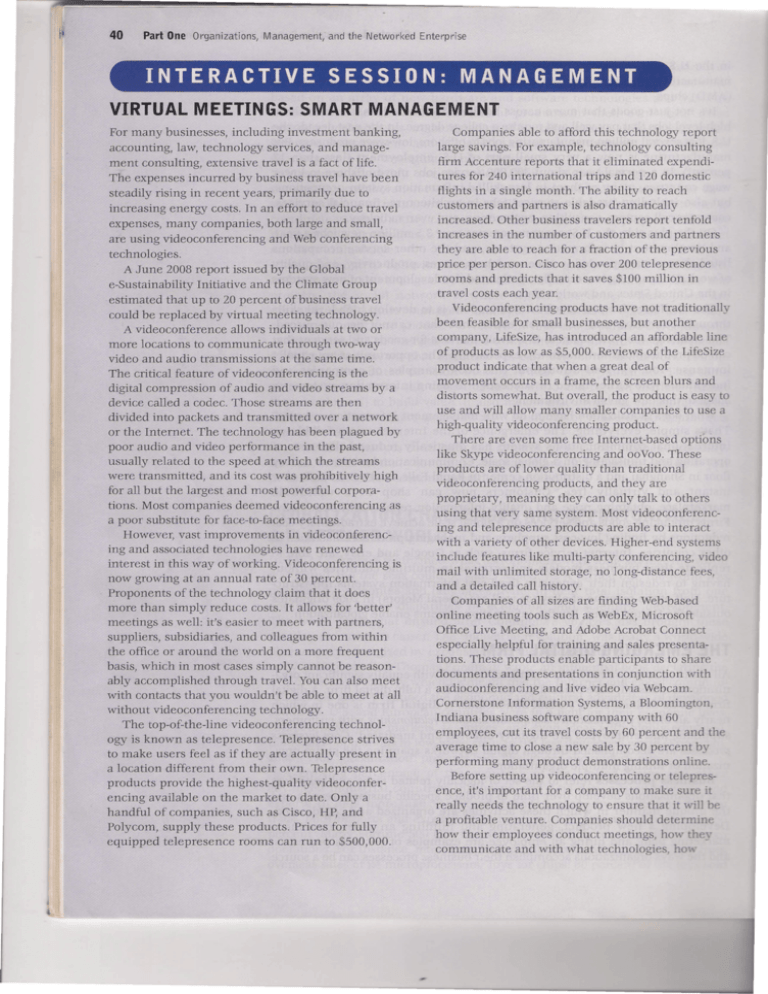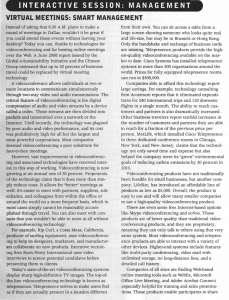interactive session: management virtual meetings: smart management
advertisement

40 Part One Organizations, Management, and the Networked Enterprise INTERACTIVE SESSION: MANAGEMENT VIRTUAL MEETINGS: SMART MANAGEMENT For many businesses, including investment banking, accounting, law, technology services, and management consulting, extensive travel is a fact of life. The expenses incurred by business travel have been steadily rising in recent years, primarily due to increasing energy costs. In an effort to reduce travel expenses, many companies, both large and small, are using videoconferencing and Web conferencing technologies. A June 2008 report issued by the Global e-Sustainability Initiative and the Climate Group estimated that up to 20 percent of business travel could be replaced by virtual meeting technology. A videoconference allows individuals at two or more locations to communicate through two-way video and audio transmissions at the same time. The critical feature of videoconferencing is the digital compression of audio and video streams by a device called a codec. Those streams are then divided into packets and transmitted over a network or the Internet. The technology has been plagued by poor audio and video performance in the past, usually related to the speed at which the streams were transmitted, and its cost was prohibitively high for all but the largest and most powerful corporations. Most companies deemed videoconferencing as a poor substitute for face-to-face meetings. However, vast improvements in video onferencing and associated technologies have renewed interest in this way of working. Videoconferencing is now growing at an annual rate of 30 percent. Proponents of the technology claim that it does more than simply reduce costs. It allows for 'better' meetings as well: it's easier to meet with partners, suppliers, subsidiaries, and colleagues from within the office or around the world on a more frequent basis, which in most cases simply cannot be reasonably accomplished through travel. You can also meet with contacts that you wouldn't be able to meet at all without videoconferencing technology. The top-of-the-line videoconferencing technology is known as telepresence. Telepresence strives to make users feel as if they are actually present in a location different from their own. Telepresence products provide the highest-quality videoconferencing available on the market to date. Only a handful of companies, such as Cisco, HP, and Polycom, supply these products. Prices for fully equipped telepresence rooms can run to $500,000. Companies able to afford this technology report large savings. For example, technology consulting firm Accenture reports that it eliminated expenditures for 240 international trips and 120 domestic flights in a single month. The ability to reach customers and partners is also dramatically increased. Other business travelers report tenfold increases in the number of customers and partners they are able to reach for a fraction of the previous price per person. Cisco has over 200 telepresence rooms and predicts that it saves $100 million in travel costs each year. Videoconferencing products have not traditionally been feasible for small businesses, but another company, LifeSize,has introduced an affordable line of products as low as $5,000. Reviews of the LifeSize product indicate that when a great deal of movement occurs in a frame, the screen blurs and distorts somewhat. But overall, the product is easy to use and will allow many smaller companies to use a high-quality videoconferencing product. There are even some free Internet-based option like Skype videoconferencing and ooVoo.These products are oflower quality than traditional videoconferencing products, and they are proprietary, meaning they can only talk to others using that very same system. Most videoconferencing and telepresence products are able to interact with a variety of other devices. Higher-end system include features like multi-party conferencing, video mail with unlimited storage, no long-distance fees, and a detailed call history. Companies of all sizes are finding Web-based online meeting tools such as WebEx,Microsoft Office Live Meeting, and Adobe Acrobat Connect especially helpful for training and sales presentations. These products enable participants to share documents and presentations in conjunction with audioconferencing and live video via Webcam. Cornerstone Information Systems, a Bloomington, Indiana business software company with 60 employees, cut its travel costs by 60 percent and the average time to close a new sale by 30 percent by performing many product demonstrations online. Before setting up videoconferencing or telepre ence, it's important for a company to make sure it really needs the technology to ensure that it will be a profitable venture. Companies should determine how their employees conduct meetings, how the communicate and with what technologies, ho ' - Chapter 1 Information Systems in Global Business Today ravel they do, and their network's capabilities. re till plenty of times when face-to-face --=~tGilCni more desirable, and often traveling to c.ient is essential for cultivating clients and ;::sale. onferencing figures to have an impact on - ie world in other ways, as well. More --~"""ee may be able to work closer to home and ;e their work and personal lives more uy- traditional office environments and _ te headquarters may shrink or disappear; and SE STUDY QUESTIONS consulting firm has predicted that video and conferencing will make business travel ct. Do you agree? Why or why not? • i the distinction between videoconferencing elepresence? - are the ways in which videoconferencing ides value to a business? Would you consider art management? Explain your answer. - ou were in charge of a small business, would choose to implement videoconferencing? a factors would you consider in your decision? 41 freelancers, contractors, and workers from other countries will become a larger portion of the global economy. Sources: Steve Lohr, "As Travel Costs Rise, More Meetings Go Virtual," The New York Times, July 22, 2008; Karen D. Schwartz, "Videoconferencing on a Budget," eWeek, May 29, 2008; and Jim Rapoza, "Videoconferencing Redux," eWeek, July 21, 2008; Mike Fratto, "High-Def Conferencing At a Low Price," Information Week, July 14,2008; Marianne Kolbasuk McGee, "Looking TntoThe workTrend Crystal Ball," information Week, June 24, 2008; Eric Krapf, "What's Video Good For?", Information Week, July 1, 2008. MIS IN ACTIO N Explore the WebExWeb site (www.webex.com) and note all of its capabilities for both small and large businesses, then answer the following questions: 1. List and describe its capabilities for small-medium and large businesses. How useful is WebEx?How can it help companies save time and money? 2. Compare WebEx video capabilities with the videoconferencing capabilities described in this case. 3. Describe the steps you would take to prepare for a Web conference as opposed to a face-to-face conference.











